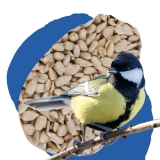Explore Our Garden Wildlife Blog
Browse or search by Category or Keyword below, alternatively click on any Tag to see related articles.


Jay Bird Habitat, Food, Identification & Facts
By Ark Wildlife
19th September 2022
Last Updated: 29th September 2022

Jay identification: what does a Jay look like
Length: 34cm.
The Jay’s plumage colouration is variable, but with it’s white rump, blue and white wing patches combined with large size make it easily identifiable. The under-tail coverts and bellies of the adult are white, the rest of the body and part of the wing coverts are brownish. The primaries are brown-black spotted bluish, fringed whitish on outer ones. The secondaries are black, the base is partly white with blue markings, innermost ones are chestnut-brown tipped black. Their bill is black and their iris is a bluish-white. The black and white feathers on the head may be erected to form a crest. Flight is slow although markedly undulating. The Jay is often seen hopping on the ground.
Jay call: what does a Jay sound like?
The Jay’s most characteristic call is a harsh ‘skaak’, although there are many variations. They have no true song but may emit, sometimes collectively, crooning notes interspersed with other harsher sounds.
Jay habitat and nesting
Jays begin breeding in late April. The nest is built by both sexes and is usually situated over two meters off the ground, usually in the fork of a tree or against the trunk. It is a cup made of twigs and stems with a little mud mixed in. The nest is lined with grasses and hair. Generally five or seven eggs, rarely three to ten, are laid. They are pale bluish or greenish, very finely speckled with olive-green or buff. Speckling may be concentrated at the larger end. Both parents incubate for about sixteen days. Both tend the young, which leave the nest after nineteen or twenty days.
Jay habitat
Jay’s like woods and areas with scattered trees, such as orchards, parks and large gardens.
How long do Jays live for?
On average, Jays live for around four years.
Where to spot Jays?
Broadleaf and coniferous forests are the best places to spot these beautiful birds. You’ll often find them near oak trees, since they love to feed on acorns. These birds will also venture out into parks or mature gardens to search for more acorns, particularly in the autumn months. Whilst Jays are very colourful and easy to identify, they are shy and secretive birds.
Jay food: what do jays eat?
The Jay eats mainly vegetable matter, such as berries, nuts and seeds. They also like molluscs, insects, small mammals and young birds. In the autumn Jays feed extensively on acorns burying the surplus in soil, for later consumption.
Are Jays in decline?
Fortunately, the population of Jays seems to be stable and this species currently has a green conservation status. It’s thought that the UK has around 170,000 pairs of breeding Jays. These birds are also protected under the Wildlife and Countryside Act of 1981.
Where to feed Jays
Ground – Scatter food in the open












